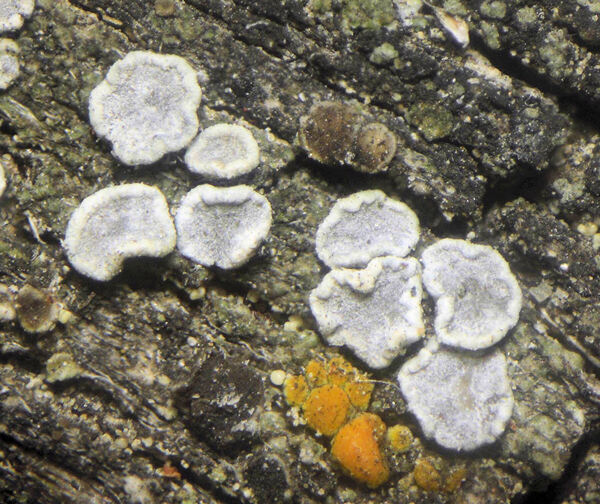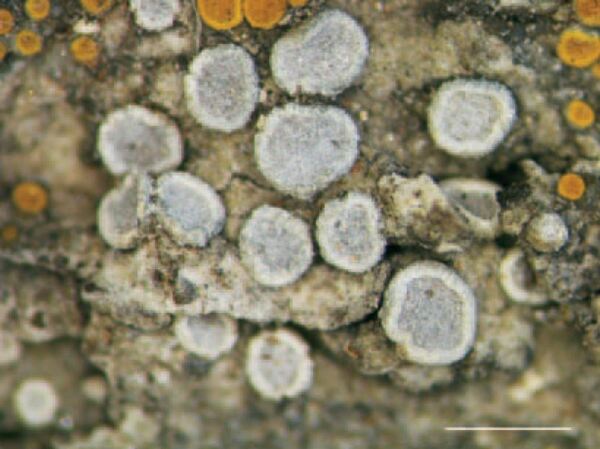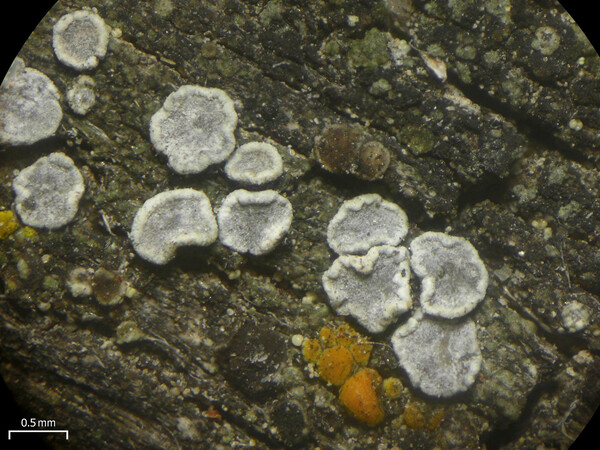Polyozosia wetmorei (Śliwa) S.Y. Kondr., Lőkös & Farkas
in Kondratyuk & al., Acta Bot. Hung., 62, 1-2: 104, 2020. Basionym: Lecanora wetmorei Sliwa in Nash & al. - Lichen Flora Gr. Sonoran Desert Reg., 2: 283, 2004.
Synonyms: Myriolecis wetmorei (Śliwa) Śliwa, Zhao Xin & Lumbsch
Description: Thallus crustose, endosubstratic and poorly evident. Apothecia lecanorine, sessile, 0.4-1.2(-1.5) mm across, with a pale brown to black, but densely bluish-pruinose, smooth, mostly flat disc and an entire, smooth, white-pruinose thalline margin. Thalline exciple 80-190 μm wide, corticate, the cortex 16-20 μm thick laterally, 60-100 μm thick at base, with granules visible under polarized light, which are insoluble in K but soluble in N; proper exciple very thin or indistinct; epithecium yellowish or pale brown, with the same granules as the apothecial cortex and sometimes with larger granules soluble in K but insoluble in N; hymenium colourless, 50–65 μm high; paraphyses simple or sparingly branched, slightly expanded at tips, more or less free in K; subhymenium distinct, granular; hypothecium colourless, 40-50 μm high, of adglutinated hyphae. Asci 8-spored, elongate-clavate, very thin-walled, with a K/I+ blue, tall tholus penetrated by a faintly amyloid apical cushion, the wall K/I-, surrounded by a K/I+ blue outer layer, Lecanora-type. Ascospores 1-celled, hyaline, ellipsoid to narrowly ellipsoid, 9-14 x 4.5-6 µm. Photobiont chlorococcoid. Spot tests: thallus and apothecia K-, C-, KC-, P-, UV-. Chemistry: without lichen substances or sometimes with traces of an unknown compound.
Growth form: Crustose
Substrata: bark
Photobiont: green algae other than Trentepohlia
Reproductive strategy: mainly sexual
Commonnes-rarity: (info)
Alpine belt: absent
Subalpine belt: extremely rare
Montane belt: extremely rare
Dry submediterranean belt: absent
Humid submediterranean belt: absent
Padanian area: absent
pH of the substrata:
1 2 3 4 5
Solar irradiation:
1 2 3 4 5
Aridity:
1 2 3 4 5
Eutrophication:
1 2 3 4 5
Poleotolerance:
0 1 2 3
Altitudinal distribution:
1 2 3 4 5 6
Rarity
absent
extremely rare
very rare
rare
rather rare
rather common
common
very common
extremely common
Loading data...
Occurrence data
Predictive map
Growth form: Crustose
Substrata: bark
Photobiont: green algae other than Trentepohlia
Reproductive strategy: mainly sexual
Commonnes-rarity: (info)
Alpine belt: absent
Subalpine belt: extremely rare
Montane belt: extremely rare
Dry submediterranean belt: absent
Humid submediterranean belt: absent
Padanian area: absent
pH of the substrata:
| 1 | 2 | 3 | 4 | 5 |
Solar irradiation:
| 1 | 2 | 3 | 4 | 5 |
Aridity:
| 1 | 2 | 3 | 4 | 5 |
Eutrophication:
| 1 | 2 | 3 | 4 | 5 |
Poleotolerance:
| 0 | 1 | 2 | 3 |
Altitudinal distribution:
| 1 | 2 | 3 | 4 | 5 | 6 |
Rarity
absent
extremely rare
very rare
rare
rather rare
rather common
common
very common
extremely common
Loading data...
Occurrence data
Predictive map









